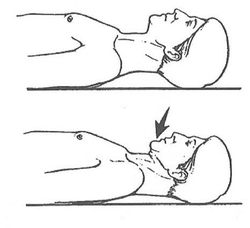
Tuck your chin in without allowing your head to tilt forward or backwards. If they aren’t able to do this, somethings you can try.

You also want them to be working on a chin tuck.

It is important to consult your doctor or physical therapist before performing any of these exercises. Weve put together our 5 favourite neck exercises to get you started. The typical way to perform this exercise is with a little one lying on their back, you grasp their hands, give a few gentle tugs to have them try to pull on you (the pull to sit is that they are pulling on you), and then you guide them up. Remember, there are many different causes of neck pain and not everyone’s neck pain is the same. Hold for a few seconds and then release Repeat this exercise several times a day, gradually increasing the duration of the hold. Tuck your chin in towards your chest, making sure to keep your head level and your back straight. Fighting against gravity makes it a bit more difficult to maintain that neutral chin retraction while in this position.įor each exercise, perform 2 to 3 sets of 15 reps, holding for 5 seconds each. Stand or sit with your back straight and your chin level. Do the same chin retraction exercise from exercise 1. Gently lift the head off the towel.Įxercise 3: Quadruped chin tuck Kneel with your knees under your hips, and your hands under your shoulders. Retract your chin over the top of your shoulders.Įxercise 2: Chin tuck with lift Maintain the chin retraction from exercise 1. In the video above, Jared Brown, a physical therapist at Sharp Grossmont Hospital, explains the importance of proper head positioning and helps demonstrate three simple exercises to strengthen the deep neck flexors.Įxercise 1: Chin tuck Lie on your back on a firm and sturdy surface. Pain resulting from poor head positioning, sometimes called “text neck,” can be avoided. Exercises covered are effortful swallow, chin tuck agains.

This causes them to become very weak, making it difficult to support the head. Instructions for individuals or caregivers of individuals with dysphagia (ie, swallowing problems). From a neutral posture, pull your chin straight backwards, in effect attempting to make a double chin. It recruits the deep neck flexor muscles and helps to restore intersegmental stability to the neck. Neck Retraction/Chin Tuck Exercise Instructions: Step 1. Over time, leaning the head forward to look at devices can cause degenerative changes to the spine, including a shortening of the neck muscles. One of our favorite exercises is the chin tuck. Maintaining that flex-forward position puts 60 pounds of force through the cervical spine, based on the weight of the head and gravity alone. When we use our cellphones, tablets and laptops, we tend to bring our neck down toward the device.


 0 kommentar(er)
0 kommentar(er)
